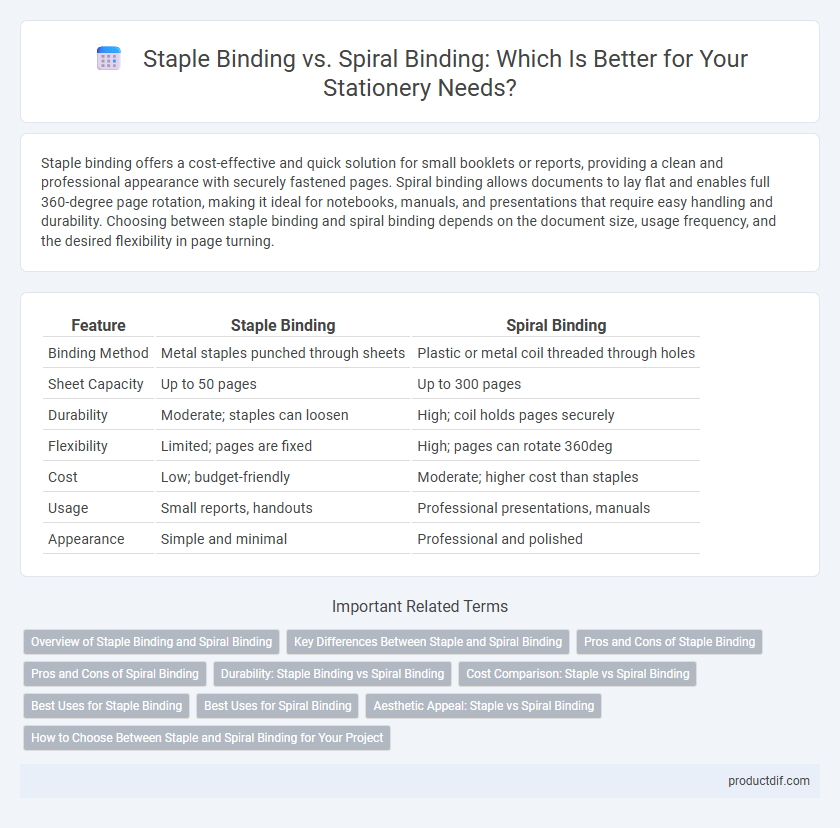Staple binding offers a cost-effective and quick solution for small booklets or reports, providing a clean and professional appearance with securely fastened pages. Spiral binding allows documents to lay flat and enables full 360-degree page rotation, making it ideal for notebooks, manuals, and presentations that require easy handling and durability. Choosing between staple binding and spiral binding depends on the document size, usage frequency, and the desired flexibility in page turning.
Table of Comparison
| Feature | Staple Binding | Spiral Binding |
|---|---|---|
| Binding Method | Metal staples punched through sheets | Plastic or metal coil threaded through holes |
| Sheet Capacity | Up to 50 pages | Up to 300 pages |
| Durability | Moderate; staples can loosen | High; coil holds pages securely |
| Flexibility | Limited; pages are fixed | High; pages can rotate 360deg |
| Cost | Low; budget-friendly | Moderate; higher cost than staples |
| Usage | Small reports, handouts | Professional presentations, manuals |
| Appearance | Simple and minimal | Professional and polished |
Overview of Staple Binding and Spiral Binding
Staple binding involves securing printed pages with metal staples along the spine, offering a cost-effective and durable solution for small booklets and reports typically with up to 60 pages. Spiral binding uses a continuous plastic or metal coil threaded through punched holes, allowing books to lie flat and pages to turn 360 degrees, ideal for manuals and notebooks requiring frequent handling. Both methods cater to different needs based on document thickness, flexibility, and ease of use.
Key Differences Between Staple and Spiral Binding
Staple binding secures pages with metal staples along the spine, offering a cost-effective solution ideal for small booklets or reports, while spiral binding uses a plastic or metal coil threaded through punched holes, providing durability and allowing pages to lie flat or rotate fully. Staple binding typically supports fewer pages, up to around 60, whereas spiral binding can accommodate thicker documents exceeding 300 pages. Spiral binding offers greater flexibility and aesthetic options, making it suitable for presentations, manuals, and notebooks requiring frequent handling.
Pros and Cons of Staple Binding
Staple binding is a cost-effective method ideal for small documents with up to 50 pages, providing a neat and secure hold that keeps pages firmly together. Its limitation lies in reduced flexibility, as it does not allow for easy page additions or lay-flat reading, unlike spiral binding. Ideal for professional reports and booklets, staple binding may cause pages near the spine to become difficult to turn, impacting user convenience.
Pros and Cons of Spiral Binding
Spiral binding offers flexibility and durability, allowing pages to lie flat and rotate 360 degrees, which enhances ease of use for note-taking and presentations. It is suitable for documents that require frequent handling but may be less professional in appearance compared to staple binding, making it less ideal for formal reports. The cons include susceptibility to coil damage or deformation and potential difficulty in inserting additional pages once bound.
Durability: Staple Binding vs Spiral Binding
Staple binding offers moderate durability, suitable for lightweight documents but prone to pages loosening over time with frequent use. Spiral binding provides superior durability by securely holding thicker sets of pages together, allowing for easy flipping without damaging the spine. The metal or plastic coils in spiral binding withstand repeated handling better, making them ideal for frequently referenced materials.
Cost Comparison: Staple vs Spiral Binding
Staple binding typically costs less than spiral binding due to its simpler materials and faster assembly process, making it a budget-friendly option for smaller documents. Spiral binding involves a plastic or metal coil that increases production expenses but provides better durability and flexibility. For high-volume or long-lasting projects, the higher cost of spiral binding may be justified by its enhanced functionality and professional appearance.
Best Uses for Staple Binding
Staple binding is ideal for small document sets such as reports, pamphlets, and booklets with fewer than 50 pages due to its cost-effectiveness and quick assembly. It provides a secure hold for lightweight materials like newsletters and flyers, making it suitable for office and academic use. This binding method is best when simplicity and durability are prioritized over expandability or aesthetic flexibility.
Best Uses for Spiral Binding
Spiral binding excels for documents that require frequent handling and lay-flat usability, such as notebooks, manuals, and presentations. Its flexible plastic or metal coil allows pages to turn easily and fold back completely, making it ideal for reference materials and instructional booklets. This binding method also supports adding or removing pages without damaging the spine, which suits dynamic content like training guides and catalogs.
Aesthetic Appeal: Staple vs Spiral Binding
Staple binding offers a clean, minimalistic aesthetic ideal for professional reports and booklets, giving documents a polished, compact look. Spiral binding provides a modern, functional appeal with visible coiled wire or plastic that enhances flexibility and ease of page-turning. Choosing between staple and spiral binding depends on whether the priority is sleek presentation or a dynamic, user-friendly design.
How to Choose Between Staple and Spiral Binding for Your Project
Choosing between staple binding and spiral binding depends on the nature and purpose of your project, such as the page count and intended durability. Staple binding suits smaller documents like pamphlets or reports with fewer pages, offering a cost-effective, simple solution. Spiral binding is ideal for larger projects requiring frequent page-turning and flexibility, providing durability and a professional look.
Staple Binding vs Spiral Binding Infographic

 productdif.com
productdif.com